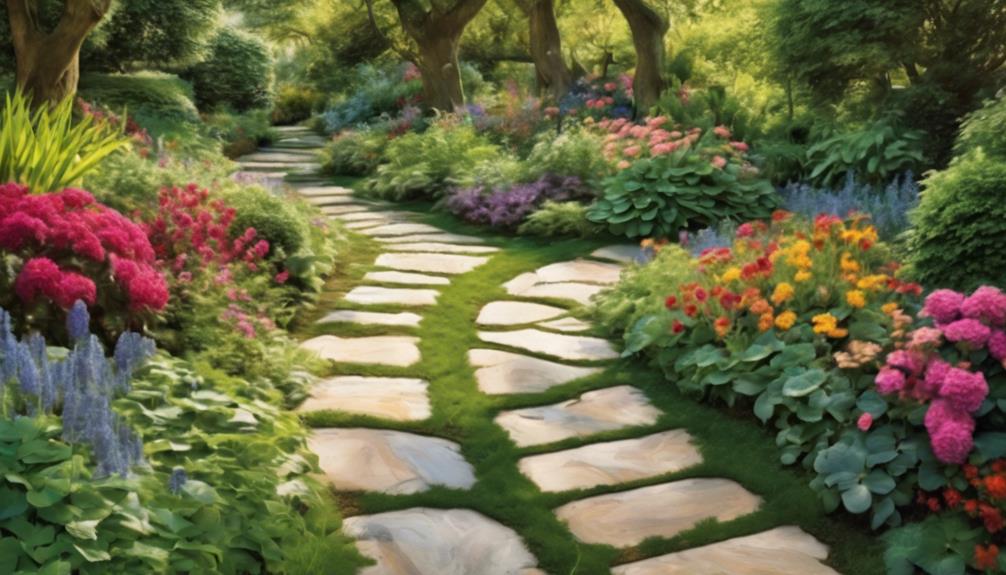
Finding Top Hardscaping Contractors in Your Area
20 October 2024
What Are the Benefits of Custom Stone Pathways?
20 October 2024When planning custom stone pathways in gardens, consider the following tips: choose durable materials such as granite or limestone that harmonise with the landscaping.
Employ a thoughtful layout—opt for meandering paths with a minimum width of 90 cm and consistent spacing of 5 to 10 cm between stones.
Factor in drainage solutions to prevent water pooling, and ensure regular maintenance to retain aesthetic appeal.
Incorporate textures for visual interest and create pathways that enhance property value.
Tailored designs can perfectly reflect personal style while promoting usability.
Investigate further insights to elevate your garden design with effective stone pathway strategies.
Pathway Design Essentials
When designing custom stone pathways, careful consideration of materials is vital to ensure durability and aesthetic appeal.
Furthermore, the layout and spacing techniques play a significant role in creating a functional and visually harmonious path.
Understanding these fundamentals will aid in crafting pathways that enhance the overall garden experience.
Material Selection Considerations
Choosing the right materials for stone pathways is critical to achieving both aesthetic appeal and functional durability in garden design.
The selection process begins with an assessment of local climatic conditions, as certain stones withstand moisture or extreme temperatures better than others. Consideration of foot traffic is also significant; dense materials like granite provide resilience, while softer stones such as limestone may wear more quickly.
Furthermore, the colour and texture of the stones should harmonise with the surrounding landscape, enhancing the overall design without overwhelming it. Sustainability is another fundamental factor; opting for locally sourced materials can minimise environmental impact.
Ultimately, the right material choice harmonises beauty and longevity, ensuring the pathway withstands the test of time while enriching the garden's visual narrative.
Layout and Spacing Techniques
Effective layout and spacing techniques are essential for creating a visually appealing and functional stone pathway in any garden. Begin by evaluating the garden's overall design, ensuring the pathway complements existing features.
Utilise a curved or meandering layout to enhance visual interest while maintaining a natural flow. Consider the width of the pathway; typically, a minimum of 90 centimetres allows for comfortable passage.
When placing stones, ensure consistent spacing—commonly 5 to 10 centimetres apart—to facilitate foot traffic and avoid tripping hazards. Moreover, consider the use of edging materials to define the pathway and prevent stone displacement.
Material Selection and Durability
Selecting the appropriate materials for stone pathways is crucial for ensuring longevity and aesthetic harmony within garden landscapes.
Factors such as weather resistance, variations in surface texture, and overall visual appeal must be meticulously considered to achieve a durable and cohesive design.
This selection process not only enhances the pathway's functionality but also complements the surrounding environment.
Weather Resistance
In the realm of custom stone pathways, selecting materials that can withstand the rigours of weather is paramount for ensuring durability and longevity.
The right choices not only enhance the aesthetic appeal but also secure the pathway's structural integrity against environmental factors.
Consider the following materials for optimal weather resistance:
- Granite: Renowned for its hardness and resistance to abrasion, making it ideal for high-traffic areas.
- Slate: Offers natural slip resistance and effectively withstands freeze-thaw cycles.
- Limestone: Aesthetic yet porous; ensure proper sealing to enhance durability against moisture.
- Bluestone: Known for its resilience, it retains its colour and texture even under harsh weather conditions.
Choosing wisely will guarantee that your stone pathways endure through time and the elements.
Aesthetic Appeal and Harmony
The selection of materials for custom stone pathways extends beyond mere functionality; it also greatly influences the entire aesthetic appeal and harmony within a garden landscape.
Thoughtfully chosen stones can create a seamless integration with the surrounding flora, enhancing the visual narrative of the space.
- Natural Flagstone: Offers an organic look, blending effortlessly with plants.
- River Rocks: Introduces texture and a soothing sound, evoking tranquillity.
- Granite Slabs: Provides a robust and timeless elegance, perfect for structured gardens.
- Limestone: Adds warmth and a rustic charm, ideal for Mediterranean-inspired designs.
Selecting the right materials guarantees durability while maintaining visual coherence, thereby elevating the garden's overall ambiance.
Surface Texture Variations
Surface texture plays a pivotal role in the functionality and longevity of custom stone pathways. Different textures not only contribute to the aesthetic appeal but also determine slip resistance, drainage efficiency, and overall durability.
When selecting materials, it is crucial to consider how surface variations can enhance performance in diverse environmental conditions.
- Smooth finishes: Offer an elegant aesthetic; however, they can be slippery when wet.
- Rough-textured stones: Provide superior grip, making them ideal for high-traffic areas.
- Natural clefts: Introduce irregularities that promote effective water runoff.
- Honed surfaces: Balance visual appeal with a functional texture, suitable for pedestrian pathways.
Planning Your Layout
When planning your stone pathway layout, it is crucial to define its purpose, whether for aesthetic appeal or functional use.
Incorporating natural stone edging can enhance the design while providing structural integrity, and employing textured stone layering techniques can add visual interest.
Careful consideration of these elements will result in a pathway that is both beautiful and practical.
Define Your Pathway Purpose
Defining the purpose of your pathway is a crucial step in planning its layout, as it influences both design and functionality.
Consider the specific roles your pathway will serve in your garden. A clear purpose will guide your decisions regarding materials, shape, and placement.
- Access: Ensure easy navigation between key areas, such as seating or planting zones.
- Aesthetics: Enhance visual appeal by integrating the pathway with surrounding flora and architectural features.
- Flow: Encourage seamless movement, maintaining a natural rhythm that invites exploration.
- Functionality: Cater to specific needs, such as accommodating foot traffic or providing a tranquil space for reflection.
Use Natural Stone Edging
Incorporating natural stone edging into your garden pathway enhances both its structure and aesthetic appeal. This technique not only delineates the pathway but also elevates the overall balance of your landscape design.
By selecting the appropriate stones, you can create a seamless transition between the pathway and surrounding flora.
Consider the following elements when planning your layout:
- Variety of Sizes: Use stones of varying sizes to create visual interest.
- Colour Coordination: Choose stones that complement your garden's colour palette.
- Natural Textures: Embrace organic shapes and textures to foster a rustic charm.
- Durability: Opt for robust stones that can withstand weather elements and foot traffic.
These considerations will elevate your garden pathway to a masterfully crafted feature.
Textured Stone Layering Techniques
How can textured stone layering transform your garden pathway? This technique not only enhances visual appeal but also creates a tactile experience that invites exploration.
By skillfully arranging stones of varying sizes, shapes, and textures, you can achieve an enchanting pathway that harmonises with the natural environment.
- Layering Techniques: Utilise larger stones as a base, then intersperse smaller, textured stones to create depth.
- Colour Variation: Incorporate stones of different hues to establish contrast and intrigue.
- Natural Patterns: Aim for asymmetry to emulate organic forms found in nature.
- Functional Design: Ensure that each layer supports stability and drainage, preserving the integrity of the pathway.
Mastering these techniques will significantly enhance your garden's aesthetic and functionality.
Enhanced Property Value
As homeowners seek ways to enhance their outdoor spaces, custom stone pathways have emerged as a compelling solution that not only improves the aesthetic appeal of gardens but also significantly increases property value. These pathways serve as visual focal points while enhancing functionality and guiding visitors through the landscape.
| Feature | Benefit | Impact on Value |
|---|---|---|
| Aesthetic Appeal | Enhances garden beauty | Attracts potential buyers |
| Durability | Long-lasting investment | Reduces maintenance costs |
| Customisation | Tailored design options | Reflects personal style |
| Accessibility | Easy navigation | Increases usability of space |
Investing in custom stone pathways is a strategic enhancement that offers both immediate enjoyment and long-term financial returns.
Landscape Design Integration
Integrating custom stone pathways into landscape design not only enhances the aesthetic appeal of a garden but also serves practical purposes.
These pathways can effectively connect garden seating areas, facilitate outdoor gatherings, and create pet-friendly spaces, ensuring that the landscape is both beautiful and functional.
Thoughtful placement and design of these pathways can significantly elevate the overall experience of the outdoor environment.
Garden Seating Area Enhancement
Enhancing a garden seating area requires thoughtful landscape design integration that harmonises aesthetics with functionality. The seating arrangement should be seamlessly incorporated into the comprehensive garden design, ensuring it invites relaxation and social interaction.
Consider the following elements to elevate your seating space:
- Natural Stone Benches: Utilise locally sourced stone for durability and a rustic charm.
- Surrounding Flora: Integrate lush plantings that provide privacy and a sense of enclosure.
- Mood Lighting: Install subtle lighting options to create an enchanting ambience during evening gatherings.
- Pathway Connectivity: Design custom stone pathways that gracefully lead to the seating area, enhancing accessibility and visual appeal.
Pathway for Outdoor Gatherings
Custom stone pathways serve as a crucial component in landscape design, particularly for outdoor gatherings. They not only provide functional access to different areas but also enhance the aesthetic appeal of the space.
When designing these pathways, consider the following elements to improve the overall experience:
- Natural Integration: Select stones that harmonise with existing flora and terrain.
- Flow and Connectivity: Create a seamless link between seating areas, fire pits, and dining spaces.
- Diverse Textures: Use a mix of stone types to create visual interest and tactile experiences.
- Illumination Options: Incorporate subtle lighting along pathways to guide guests and enhance ambience during evening events.
These considerations ensure that your outdoor gatherings are both inviting and elegantly designed.
Pathway for Pet-Friendly Spaces
Creating a pet-friendly pathway within a garden setting is essential for ensuring both safety and enjoyment for furry companions.
Thoughtful design elements can enhance the experience for pets while maintaining the aesthetic appeal of your landscape. Consider the following:
- Durable Materials: Choose stones that can withstand wear from claws and paws, such as granite or slate.
- Gentle Edges: Opt for rounded stones to prevent injury and ensure a comfortable walking surface.
- Natural Borders: Incorporate low-growing plants or grasses along the path to create a soft, inviting atmosphere.
- Shade Options: Design pathways that include shaded areas to protect pets from excessive heat during warm days.
Pathway Maintenance and Repair
Maintaining and repairing custom stone pathways is crucial for ensuring their longevity and aesthetic appeal.
Key considerations include techniques for levelling uneven stones, implementing effective drainage solutions, and methods to prevent root growth that can disrupt the pathway's integrity.
Addressing these factors will enhance both the functionality and visual charm of garden pathways.
Uneven Stone Leveling Techniques
Uneven stones can disrupt the aesthetic and functionality of garden pathways, necessitating effective levelling techniques for proper maintenance and repair.
Mastering these techniques not only enhances the visual appeal but also ensures safety for users.
To achieve a well-levelled pathway, consider the following methods:
- Excavation: Remove surrounding soil to accurately adjust the height of the stones.
- Compaction: Use a tamper to compact the soil beneath the stones for stability.
- Shimming: Insert small shims or gravel beneath uneven stones to achieve the desired height.
- Repositioning: Carefully lift and adjust the stones as needed, ensuring they sit flat and even.
Drainage Solutions for Pathways
Effective drainage solutions are crucial for preserving the integrity of stone pathways in gardens. Properly managing water flow prevents erosion, mould growth, and structural damage, ensuring that your pathways remain both functional and aesthetically pleasing.
Consider the following drainage strategies:
- Grading: Ensure pathways slope away from surrounding areas to facilitate water runoff.
- French Drains: Install perforated pipes beneath the pathways to redirect excess water.
- Permeable Pavers: Utilise stones that allow water to seep through, reducing surface runoff.
- Regular Maintenance: Clean gutters and drains regularly to prevent blockages that can lead to pooling.
Implementing these drainage solutions will enhance the longevity and performance of your stone pathways, fortifying them against water-related issues.
Root Growth Prevention Methods
Water management strategies not only protect stone pathways from erosion and damage but also play a significant role in preventing root growth that can disrupt the integrity of these structures.
Implementing effective root growth prevention methods is essential for maintaining the aesthetics and functionality of your pathways.
- Utilise Root Barriers: Install physical barriers such as geotextiles or plastic sheeting to deter roots from encroaching on pathways.
- Choose Appropriate Planting: Select shallow-rooted plants and trees positioned away from pathways to minimise root competition and expansion.
- Regular Inspections: Periodically assess pathways for signs of root intrusion, addressing issues promptly to prevent extensive damage.
- Optimise Soil Composition: Improve soil drainage and aeration to create an environment less conducive to aggressive root growth.
Why Choose TKL Birmingham Gardener
Choosing TKL Birmingham Gardener is often regarded as a prudent decision for those looking to enhance their outdoor spaces with custom stone pathways.
With extensive experience in landscape design, TKL Birmingham Gardener specialises in creating bespoke pathways that seamlessly blend aesthetics and functionality. Their team employs meticulous craftsmanship, ensuring that each stone is thoughtfully selected and expertly laid to enrich the natural beauty of your garden.
Committed to sustainability, TKL utilises eco-friendly materials and practices, contributing to environmentally responsible landscaping.
Furthermore, their personalised approach means that client preferences are prioritised, resulting in unique designs tailored to individual tastes.
Common Pathway Questions Answered
Navigating the realm of custom stone pathways can raise numerous questions for homeowners keen to enhance their gardens. One common inquiry pertains to the ideal materials; selecting the right stone—such as granite, limestone, or slate—depends on both aesthetics and durability.
Another frequent concern is the installation process; proper grading and base preparation are critical to ensuring stability and longevity. Homeowners often wonder about maintenance; regular cleaning and occasional sealing can preserve the pathway's appearance and functionality.
Furthermore, questions regarding design often arise—should pathways be straight or meandering? Ultimately, the choice should reflect personal style while enhancing the garden's flow.
Addressing these questions can lead to informed decisions, resulting in a pathway that harmonises beauty with practicality.
Future Pathway Enhancements
As homeowners consider the long-term impact of their stone pathways, the potential for future enhancements becomes a focal point. Improving pathways not only increases their aesthetic appeal but also reinforces their functionality.
To enhance your garden's stone pathways, consider the following improvements:
- Integrated Lighting: Install low-voltage lighting to illuminate pathways, improving safety and ambience during evening use.
- Edging Solutions: Utilise natural stone or metal edging to clearly define pathways, preventing soil erosion and maintaining integrity.
- Native Plant Integration: Incorporate native plants alongside pathways for ecological benefits and visual interest, fostering biodiversity.
- Seasonal Decoration: Design pathways that can accommodate seasonal decorations, allowing for dynamic changes throughout the year that reflect personal style.
These enhancements ensure that stone pathways remain both beautiful and practical over time.



